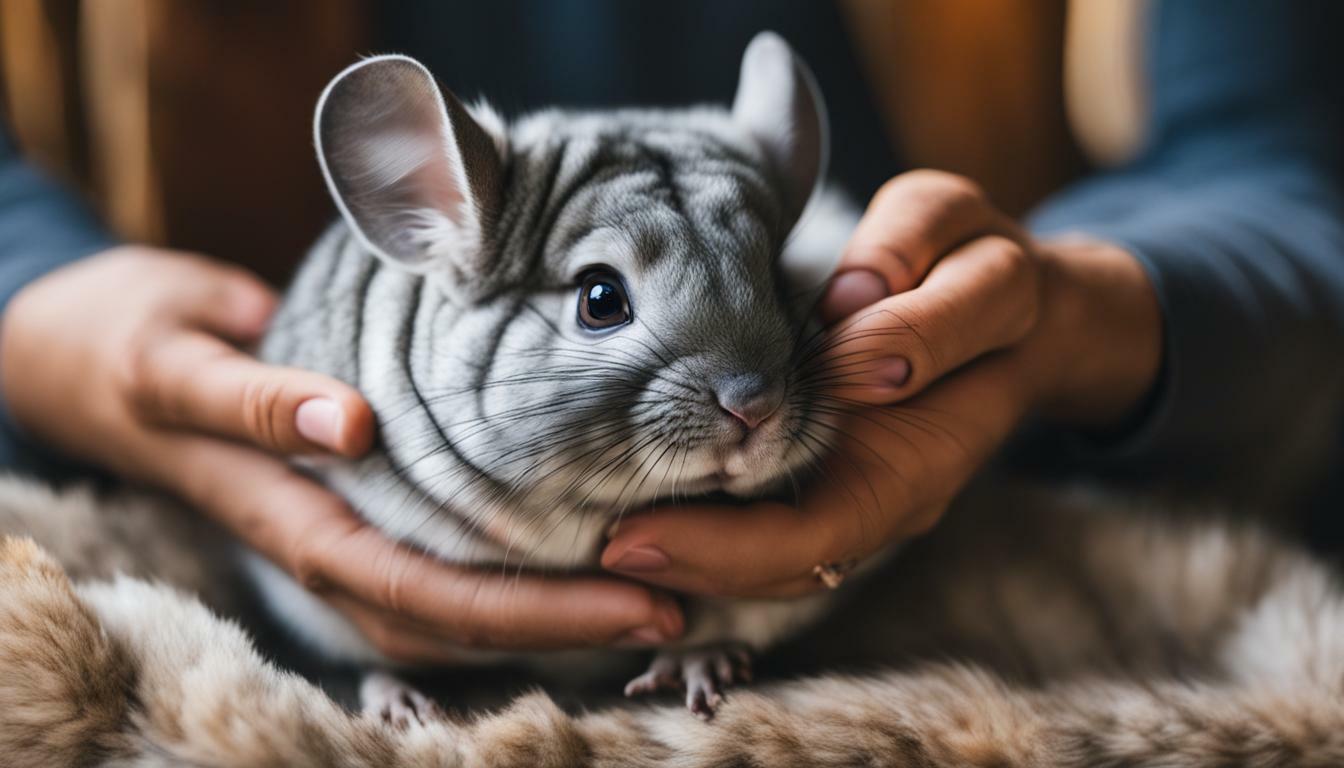Chinchillas are known for their unique ways of showing affection towards their human companions. These adorable creatures have their own language of love, and understanding their behaviors and signals is key to building a strong bond with them. In this section, we will explore the various ways in which chinchillas demonstrate their affectionate nature, helping you deepen your connection with these delightful pets.
Key Takeaways:
- Chinchillas show affection by greeting their owners, jumping, and climbing on them.
- They make squeaks and noises to express their excitement and happiness.
- Chinchillas enjoy being pet, scratched, and participating in playtime with their owners.
- They may attempt to groom their owners as a sign of affection.
- As the bond between chinchilla and owner strengthens, the chinchilla becomes more comfortable and trusting, engaging in increased affectionate behavior.
Understanding Chinchilla Bonding
Building a strong bond with your chinchilla is crucial for fostering affectionate behavior. When you invest time and effort into developing a close relationship with your furry friend, you’ll start to notice the signs of their love and affection towards you. Chinchillas show their bond in various ways, both through their actions and body language.
One of the most obvious signs of chinchilla affection is when they eagerly greet you at the front of their cage. They may jump and climb on you, excitedly interacting and seeking attention. These gestures demonstrate their trust in you as their owner and their desire for your companionship.
Additionally, chinchillas express their love through verbal cues. They may make squeaks and other noises to gain your attention and communicate their affection. These sounds, although small, carry the warmth and excitement that they feel when you are around.
Playtime is another important aspect of bonding with your chinchilla. These curious creatures enjoy engaging in interactive activities with their owners. By actively participating in play and providing them with mental stimulation, you strengthen the bond between you and your pet, which in turn increases their affectionate behavior.
| Signs of Chinchilla Affection |
|---|
| – Greeting at the front of the cage |
| – Jumping and climbing on you |
| – Making squeaks and noises |
| – Enjoying being pet and scratched |
| – Eagerly participating in playtime |
| – Attempting to groom you |
| – Getting comfortable and relaxed around you |
By recognizing and responding to these signs of affection, you can deepen your connection with your chinchilla and create a loving and nurturing environment for them. Remember, each chinchilla is unique, so observe their individual behaviors and tailor your interactions accordingly. With time, patience, and a little bit of effort, your chinchilla will reciprocate your affection and show you just how much they care.
Chinchilla Body Language of Affection
Chinchillas have a unique body language that demonstrates their affection towards their owners. Understanding their non-verbal cues is key to building a strong bond and responding to their needs. Here are some behaviors that indicate a chinchilla’s affectionate nature:
- Greeting at the front of the cage: When your chinchilla eagerly comes to the front of the cage to greet you, it’s a clear sign of affection. They are excited to see you and acknowledge your presence.
- Jumping and climbing: Chinchillas love to jump and climb on their owners. When they playfully bounce around or scramble up onto your shoulder, it’s their way of showing trust and a desire for interaction.
- Squeaks and noises: Chinchillas may make various vocalizations, such as squeaks and chirps, to express their affection. These sounds indicate their contentment and happiness in your presence.
Chinchillas also engage in physical behaviors that demonstrate their affection:
- Enjoying being pet and scratched: Chinchillas love gentle caresses and scratches behind their ears or along their back. If your chinchilla leans into your hand or closes their eyes in response to your touch, it’s a sure sign of affection.
- Participating in playtime: Playtime is not only a fun bonding activity but also a way for chinchillas to show their affection. They may eagerly chase toys or engage in games with you, which signals their enjoyment of your company.
- Nibbling or attempting to groom: Chinchillas may nibble on you gently or attempt to groom your hair or clothing. This behavior mimics their natural grooming instincts and signifies their comfort and trust in your presence.
As your bond with your chinchilla grows, you may notice an increase in affectionate behaviors. They may become more relaxed and comfortable around you, exhibiting the following signs:
“Chinchillas show affection by feeling safer and calmer, showing up at the cage doors, becoming more open to cuddles and physical interaction, accepting hand feeding, jumping and climbing around the owner, producing squawking sounds while staying calm, not hiding from the owner, not barking at the owner, cuddling up to the owner, nibbling the owner, not trying to attack the owner, and taking treats from the owner’s hand.”
These behaviors demonstrate the strong bond and trust that has developed between you and your chinchilla. By paying attention to their body language and responding to their affectionate behaviors, you can continue to strengthen your relationship and provide them with the love and care they need.
| Affectionate Behaviors | Meaning |
|---|---|
| Jumping and climbing on you | Trust and desire for interaction |
| Squeaks and chirps | Contentment and happiness |
| Enjoying being pet and scratched | Affection and comfort |
| Participating in playtime | Enjoyment of your company |
| Nibbling or attempting to groom | Comfort and trust |
Greeting and Interaction
Chinchillas have special ways of greeting their owners and initiating interaction to express their affection. When you approach their cage, they may come to the front and greet you, excitedly hopping and climbing on the bars, eager for your attention. This enthusiastic behavior is a clear sign of their fondness for you.
During playtime, chinchillas often engage in interactive behaviors to show their affection. They may jump onto your shoulder or climb onto your lap, seeking physical contact and closeness. Their playful nature shines through as they eagerly participate in games and toys, inviting you to join in the fun.
Chinchillas also communicate their affection through vocal expressions. They may make squeaks, chirps, or other noises to express their joy and happiness while interacting with you. These sounds, combined with their lively and active behavior, indicate their affectionate nature.
It is important to note that chinchillas show their affection in various ways, and it may take time for them to fully trust and bond with their owners. Patience and consistent care will help build a strong and loving relationship with these remarkable creatures.
Physical Affection
Chinchillas often seek physical affection and enjoy being pet and scratched by their owners. These cuddly creatures have a soft and dense fur coat that feels delightful to touch, making them especially receptive to gentle caresses. Petting your chinchilla not only provides them with a sensory pleasure but also strengthens the bond between you and your furry friend.
When it comes to physical interaction, it’s important to approach your chinchilla with patience and respect. Start by allowing them to sniff your hand and get accustomed to your scent. Once they feel comfortable, you can gently stroke their back, head, or chin using light and slow movements. Many chinchillas have particular areas they enjoy being scratched, so observe their body language to find their sweet spots.
In addition to petting, chinchillas may exhibit other behaviors that indicate their desire for physical affection. They may jump and climb on you, seeking your attention and physical interaction. Their playful nature comes alive as they happily explore their surroundings, including your presence. It’s important to provide a safe and secure environment during these interactions to prevent accidents or injury.
| Signs of Physical Affection in Chinchillas |
|---|
| – Seeking physical contact by climbing or jumping on you |
| – Enjoying petting and scratching, especially in their preferred spots |
| – Playfully exploring their surroundings, including interacting with you |
Remember, every chinchilla is unique, and their preferences for physical affection can vary. Pay close attention to their cues and body language to ensure they are comfortable and enjoying the interaction. Building a trusting and affectionate relationship with your chinchilla through physical contact will not only bring you joy but also provide them with the love and care they need.
Playful Bonding
Playtime is not only fun for chinchillas but also an opportunity to strengthen the bond with their owners. Chinchillas are known for their playful nature, and engaging in interactive activities with them can foster affectionate behaviors.
During playtime, your chinchilla may exhibit various behaviors that indicate a deepening bond. They may jump and climb around you, eagerly seeking your attention and participation. This shows their trust and comfort in your presence.
One way to bond with your chinchilla during playtime is through interactive toys and games. Provide them with safe toys that stimulate their natural instincts, such as tunnels, chew toys, and puzzle feeders. Engage in activities that encourage them to explore, climb, and exercise. This shared playtime experience strengthens the connection between you and your chinchilla.
Remember to observe your chinchilla’s body language during playtime. Pay attention to their level of excitement, engagement, and comfort. If they become overwhelmed or show signs of stress, such as excessive hiding or running away, give them space and adjust the intensity of the play session.
| Signs of Playful Bonding | Description |
|---|---|
| Jumping and climbing around the owner | Chinchillas exhibit a joyful and active behavior, expressing their enthusiasm and trust. |
| Producing squawking sounds while staying calm | Squawking sounds accompanied by calm behavior indicate a positive interaction and playfulness. |
| Nibbling the owner | Gentle nibbling can be a playful gesture of affection as long as it doesn’t escalate into biting or aggression. |
| Taking treats from the owner’s hand | A chinchilla willingly accepting treats from your hand demonstrates trust and a bond between you. |
By engaging in playtime and recognizing the signs of playful bonding, you can build a strong and affectionate relationship with your chinchilla. Remember to approach each play session with patience, respect, and a genuine desire to connect with your furry friend.
Communication Through Sounds
Chinchillas use various sounds to communicate their affectionate feelings towards their owners. These sounds are an integral part of their unique language and can provide valuable insights into their emotional state. By understanding the different vocal expressions of chinchillas, you can deepen your bond and strengthen your relationship with these adorable creatures.
One of the most common sounds that chinchillas make to express affection is a high-pitched squeak or chirp. This adorable noise is often accompanied by a show of excitement, such as jumping or climbing on their owners. It signifies their happiness and eagerness to interact, signaling that they enjoy your company and appreciate your presence.
Another way chinchillas communicate their affection is through soft cooing or purring sounds. These gentle vocalizations are often heard when they are being pet or receiving gentle scratches. It’s their way of showing contentment and relaxation, indicating that they trust and feel safe with you. These quiet sounds can be incredibly soothing and can further enhance the bond between you and your chinchilla.
In addition to squeaks, chirps, coos, and purrs, chinchillas also make other vocalizations to express their affection. These can include low grunts or growls, which may initially sound alarming but are actually signs of deep affection. They are often heard during playtime or when they are engaging in social interactions. These vocalizations are their way of expressing joy and excitement, and they should be interpreted as positive signs of their affectionate nature.
| Chinchilla Affectionate Behaviors | Significance |
|---|---|
| High-pitched squeaks or chirps | Express happiness and eagerness to interact |
| Soft cooing or purring sounds | Show contentment and relaxation, indicate trust |
| Low grunts or growls | Express joy and excitement during playtime or social interactions |
Understanding the sounds chinchillas use to communicate their affectionate feelings is key to developing a strong bond with your pet. By listening attentively and responding appropriately to their vocal expressions, you can create a loving and nurturing environment that fosters their happiness and well-being.
Attempts at Grooming
Chinchillas may display grooming behaviors towards their owners as a way of expressing affection. These small and furry creatures have a natural instinct to groom themselves and other chinchillas, and when they extend this behavior to their owners, it is a sign of trust and bond. As a chinchilla owner, it is important to understand and appreciate these grooming attempts as they are a special form of communication.
When a chinchilla tries to groom you, it may involve nibbling or gently chewing on your fingers, hands, or even your hair. This behavior mimics their natural grooming habits in the wild, where they clean their fur and remove debris. It is their way of showing that they see you as part of their social group and want to take care of you.
“Chinchillas have a natural instinct to groom themselves and other chinchillas, and when they extend this behavior to their owners, it is a sign of trust and bond.”
It is important to note that these grooming attempts should be gentle and not aggressive. If a chinchilla is biting or tugging too hard, it may be a sign of discomfort or fear. In such cases, it is best to gently redirect their behavior and provide them with positive reinforcement when they display more gentle grooming gestures. Always ensure that your chinchilla’s nails are properly trimmed to prevent accidental scratches during grooming sessions.
“When a chinchilla tries to groom you, it may involve nibbling or gently chewing on your fingers, hands, or even your hair. This behavior mimics their natural grooming habits in the wild.”
Grooming is just one of the many ways chinchillas show affection towards their owners. By recognizing and appreciating these grooming attempts, you can strengthen your bond with your chinchilla and create a loving and trusting relationship.
| Chinchilla grooming behaviors as a sign of affection |
|---|
| Gentle nibbling or chewing on fingers, hands, or hair |
| Imitating natural grooming habits |
| Signifying trust and bond |
| Gentle and non-aggressive behavior |
Increased Comfort and Trust
As chinchillas become more comfortable and trusting with their owners, their affectionate behaviors become more pronounced. Spending quality time with your chinchilla is key to building trust and fostering an affectionate bond. Over time, you may notice subtle changes in their behavior that indicate a deepening connection.
One way chinchillas express their growing comfort is by greeting you at the front of their cage. They might eagerly approach you, sniff your hand, or even jump onto your shoulder. This enthusiastic greeting is a sign of trust and affection, as they feel safe and secure in your presence.
| Affectionate Behaviors | Signs of Comfort and Trust |
|---|---|
| Jumping and climbing on you | Feeling relaxed and open to physical interaction |
| Making squeaks and noises | Showing an increased playfulness |
| Enjoying being pet and scratched | Accepting hand feeding |
| Participating eagerly in playtime | Jumping and climbing around you |
| Nibbling or attempting to groom you | Displaying trust and bonding behavior |
Chinchillas may also exhibit affectionate behavior by cuddling up to you or nibbling gently. These actions demonstrate their trust and desire for physical closeness. It’s important to note that each chinchilla has its own unique way of showing affection, so pay attention to their individual cues and preferences.
Overall, as your chinchilla becomes more comfortable and trusting, they will display an array of affectionate behaviors that reflect the strength of your bond. The key is to spend quality time together, provide a safe and enriched environment, and be patient as your relationship deepens. With time and love, you can expect your chinchilla to become a true companion, showing their affection in their own special way.
Conclusion
Understanding and recognizing the affectionate behaviors of chinchillas is key to developing a strong and loving bond with these amazing pets. Chinchillas show affection in various ways, such as greeting their owners at the front of the cage, jumping and climbing on them, making squeaks and noises, and enjoying being pet and scratched. By spending more time with your chinchilla, you will notice an increase in affectionate behaviors, although it may be low in the early days.
Chinchillas also display affection by eagerly participating in playtime, nibbling or attempting to groom their owners, and getting comfortable and relaxed with them. They show their affection by feeling safer and calmer, showing up at the cage doors, becoming more open to cuddles and physical interaction, and accepting hand feeding. These behaviors indicate the growing bond between you and your chinchilla.
It is important to note that chinchillas demonstrate their affection by jumping and climbing around you, producing squawking sounds while staying calm, not hiding or barking at you, and cuddling up to you. They may also nibble on you, but it is a sign of affection rather than aggression. Taking treats from your hand is another way chinchillas show their trust and affection for you.
By understanding and responding to these affectionate behaviors, you can deepen your bond with your chinchilla and create a loving and enjoyable relationship. Remember to be patient and spend quality time with your chinchilla to nurture the affectionate connection between you. Building trust and showing love will result in a happy and content chinchilla that feels cherished and valued.
FAQ
How do chinchillas show affection?
Chinchillas show affection in various ways, such as greeting their owners at the front of the cage, jumping and climbing on them, making squeaks and noises, enjoying being pet and scratched, eagerly participating in playtime, nibbling or attempting to groom their owners, getting comfortable and relaxed with them, and showing an increase in playfulness.
What are the signs of chinchilla affection?
Chinchillas show affection by feeling safer and calmer, showing up at the cage doors, becoming more open to cuddles and physical interaction, accepting hand feeding, jumping and climbing around the owner, producing squawking sounds while staying calm, not hiding from the owner, not barking at the owner, cuddling up to the owner, nibbling the owner, not trying to attack the owner, and taking treats from the owner’s hand.
Does chinchilla affection increase over time?
Yes, more time spent with a chinchilla leads to increased affection, though it may be low in the early days. Chinchillas show more affection as they feel safer and develop a stronger bond with their owners.
How can I bond with my chinchilla?
Bonding with a chinchilla involves spending quality time together, engaging in playtime, offering treats by hand, providing gentle and regular petting, and respecting their boundaries. Building trust and establishing a routine are essential for bonding with your chinchilla.
Are there any specific body language signals of chinchilla affection?
Yes, chinchillas display affection through body language by staying relaxed and calm, grooming themselves or attempting to groom their owners, initiating physical contact, and showing an overall increase in playfulness and curiosity.
How do chinchillas communicate their affection through sounds?
Chinchillas communicate their affection through sounds such as squeaks, chirps, and squawking. These sounds are usually accompanied by relaxed body language and a calm demeanor.
Can chinchillas cuddle with their owners?
Yes, chinchillas can cuddle with their owners. They may choose to cuddle up against their owners, rest in their laps, or seek physical contact during playtime and relaxation.
What are the signs of increased comfort and trust in chinchillas?
Increased comfort and trust in chinchillas are displayed through behaviors such as staying calm and relaxed around their owners, approaching the cage doors, accepting physical contact and handling, and actively seeking interaction and play.




